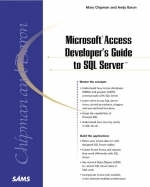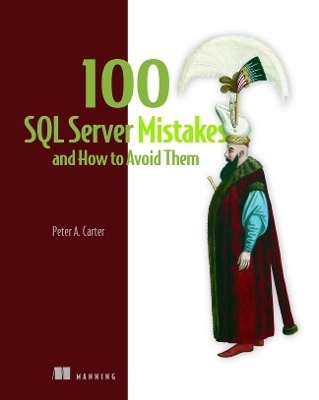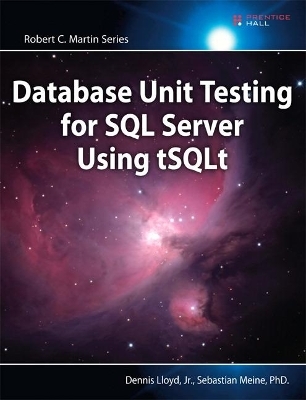
Microsoft Access Developer's Guide to SQL Server
Sams Publishing (Verlag)
978-0-672-31944-0 (ISBN)
- Titel ist leider vergriffen;
keine Neuauflage - Artikel merken
PLEASE PROVIDE
Microsoft Access 2000 Developer's Guide to Microsoft SQL Server provides much needed information and guidance for the Access power user or developer who wants to exploit the power of SQL Server. Written by Access experts and Microsoft MVPs Mary Chipman and Andy Baron, this hands-on guide provides you with the practical knowledge you need to harness the enterprise-level power and scalability SQL Server offers, while using the Access tools you are familiar with. More than just a migration guide, you will benefit from the authors' expert discussions of topics including the new Microsoft Database Engine (MSDE), Transact SQL, building stored procedures and views, converting your applications to SQL Server, working with SQL Server security, and building Access interfaces to SQL Server databases.
Mary Chipman and Andy Baron are senior consultants with MCW Technologies. They are contributing editors for the two leading Access journals, Smart Access and Access VB Office Advisor and speak regularly at industry conferences. In addition, they conduct training seminars for the Application Developers Training Company, and have been designated Access MVPs by Microsoft based on their contributions to Microsoft's online support. Lead Author Mary Chipman has co-authored two books on SQL Server--The Access and SQL Server Developers Handbook, and SQL Server 7 In Record Time.
Introduction.
1. Converting Your Access Database to SQL Server.
Reasons to Upsize.
Number of Users. Size of the Database. Performance. Transaction Logging. Data Integrity. Security. Administration. SQL Server Tools.
Getting Started with the Upsizing Wizard.
Versions of SQL Server Supported by the Upsizing Wizard. Access 2000-SQL Server 2000 Compatibility Issues. Unattended Upsizing. Upsizing Wizard Choices. What Gets Upsized. What Gets Ignored. How Indexes Are Handled. How Data Types Are Mapped. Upsizing Queries to an Access Project (ADP). Upsizing Forms to an Access Project (ADP). Upsizing Reports to an Access Project (ADP).
Upsizing Gotchas: What to Watch Out For. What About Security? Using the Upsizing Wizard to Create Linked Tables.
Upsize and Link to an Access MDB. The Upsizing Report. Testing the Result. Upsize to an Access Project. Upsizing with Previous Versions of Access.
Upsizing Using Data Transformation Services (DTS). Using Linked Servers for Data Access. Beyond Upsizing: What's Next?
How Access Handles Linked SQL Server Data. New Data Type Choices. Code Cleanup. Forms and Reports. Security.
Summary.
2. SQL Server Fundamentals.
SQL Server Editions.
Features Supported. Pricing and Licensing.
SQL Server Graphical Components.
Enterprise Manager. Query Analyzer. Performance Monitor. Data Transformation Services (DTS). Service Manager. Client Network Utility. Server Network Utility. Books Online.
The Server.
Registration Properties. Server Properties. The System Databases. System Stored Procedures. Management. Database Maintenance Plans. Replication. Security. Support Services. Meta Data Services. About Multiple Instances of SQL Server.
The Database.
Files and File Groups. The Transaction Log. Database Components.
What's New in SQL Server 2000. Installing SQL Server.
Before Installing SQL Server. Setting Up the System Accounts. Domain User Account Requirements. Installing Database Components.
Summary.
3. Understanding SQL Server Security.
Why Security Is Important.
Access Security Versus SQL Server Security.
Letting Users In.
Authentication Basics. Logins and Permissions. The Benefits of Windows NT/Windows 2000 Authentication (Integrated Security). The Benefits of SQL Server Authentication. How NT Authentication and SQL Server Authentication Work Together. Logins and Built-in Accounts. Granting Database Access to Logins. Understanding Fixed Server Roles. Understanding Fixed Database Roles. Object Owners. Working with User-Defined Database Roles. Understanding Application Roles. Keeping Track of Logins and Roles. Removing Users and Logins. Resetting SQL Server User Passwords.
Understanding Permissions.
The Three Types of Permissions. Implementing Security Using Stored Procedures. Implementing Security Using Views. Implementing Security Using User-Defined Functions. Implementing Column-Level and Row-Level Security. Encrypting Functions, Views, and Stored Procedures.
What About Access Security?
Security in an Access Database (MDB). Security in an Access Project (ADP).
Upsizing Access Security Permissions on Tables.
Defining the Goal. Determining the Methods. Using DAO to Retrieve Access Permissions. Using ADO to Set SQL Server Permissions.
Summary.
4. Introduction to Access Projects (ADPs).
About Access Projects.
Advantages of Access Projects. Disadvantages of Access Projects.
Creating a New Access Project.
Connecting to SQL Server. Designing SQL Server Objects in an Access Project.
Forms in Access Projects.
Using Form Properties. Working with the Form's Recordset.
Managing Your SQL Server Through an Access Project. Summary.
5. Linking to SQL Server Using Access Databases (MDBs).
Advantages of Using a Jet Database (MDB) Front End. How Jet Uses ODBC.
ODBC Components. Setting Up a DSN with the ODBC Data Source Administrator.
Working Efficiently with Linked Tables.
Linking Tables. Size Matters.
Creating Efficient Bound Forms.
Form Properties. Restricting Data with Prefiltering. Loading a Single Record from an Unbound Form. Filling List Boxes and Combo Boxes on Demand. Minimizing the Number of Recordsets Open.
Using Pass-Through Queries.
Creating a Pass-Through Query. Running a Stored Procedure from a Pass-Through Query. How to Pass Parameters to a Pass-Through Query. A Generic Procedure for Modifying Pass-Through Queries.
Caching Data in Local Tables.
Creating Local Tables. Refreshing Data in Local Tables.
Tweaking ODBC Settings to Tune Performance.
Using the Options Dialog Box. Using the Windows Registry. Using an MSysConf Table.
Summary.
6. ActiveX Data Objects (ADO) Fundamentals.
A Short History of Data Access Technologies.
ODBC (Open Database Connectivity). DAO (Data Access Objects). Remote Data Objects (RDO). OLE DB. ADO (ActiveX Data Objects).
Getting Started with ADO.
Setting a Reference to the ADODB Object Library.
Creating an ADO Connection Object.
Declaring and Creating a Connection Object. Opening the Connection Object. Connection Properties and Methods.
Creating an ADO Recordset Object.
The Recordset's Open Method. Opening a Recordset. Updating Data Using Recordsets. Navigating, Searching, Filtering, and Sorting.
Creating an ADO Command Object.
Command Object Properties and Methods. The Execute Method. Executing a Simple Command. Executing a SQL Statement with Parameters. Executing a Stored Procedure. Executing a Stored Procedure with Parameters.
Mixing and Matching the Three Objects.
Opening Recordsets with Command Objects. Reusing Command Objects with Recordsets. Going Solo with the Connection Object. Returning Multiple Recordsets.
Advanced ADO.
Creatable Recordsets. Persistent Recordsets. ADO Events. SHAPE: Creating Hierarchical Recordsets. Streams and Records.
Other ADO Libraries.
Microsoft ADO Extensions for DDL and Security (ADOX). Microsoft Jet and Replication Objects 2.1 (JRO). Microsoft ActiveX Data Objects Recordset (ADOR). Microsoft ActiveX Data Objects (Multidimensional) (ADOMD). ADO.NET.
Choosing the Best Tool for the Job at Hand.
When DAO Is the Best Choice. When ADO Is the Best Choice.
Summary.
7. Designing and Creating a SQL Server Database.
Designing a Relational Database.
Review of Relational Database Design Principles.
Implementing Your Design in SQL Server 2000.
How Databases Are Stored in Files. How the Transaction Log Works. Creating Databases Using the Enterprise Manager. Creating and Modifying Tables. Setting Relationships Between Tables.
Summary.
8. Introduction to Transact-SQL (T-SQL).
Defining Transact-SQL.
A Brief History of the SQL Standard. The Evolution of SQL Server. What You Can Do with Transact-SQL. Working with Transact-SQL.
Referring to Objects. Selecting Data.
The SELECT Statement. The WHERE Clause. The ORDER BY Clause. Summarizing and Aggregating Data. The GROUP BY Clause. The HAVING Clause.
Joins.
Inner Joins. Outer Joins. Full Joins. Self-Joins. Using Subqueries. Union Queries.
Updating Data with Action Queries.
Using the INSERT Statement to Add Rows to a Table. Using SELECT INTO to Create a Temp Table. Using the UPDATE Statement to Modify Data. Using the DELETE and TRUNCATE Statements to Delete Data.
Using Transact-SQL Functions.
Working with Nulls. Date Functions. String Functions. Functions to Return Information. New! User-Defined Functions.
Programming in Transact-SQL.
Batches. Variables. Control of Flow Syntax.
Other Querying Techniques.
Top Values Queries. Creating Distributed Queries with Linked Servers.
Summary.
9. Creating and Optimizing Views.
Defining Views.
View Syntax. What Views Are Good For. Rules for Creating and Using Views. Views and Security.
Creating and Modifying Views.
Creating Views Using the Create View Wizard. Creating Views Using the Enterprise Manager. Creating Views Using an Access Project. Creating Views Using the Query Analyzer. Using ALTER VIEW to Modify a View. Views, Subqueries, and Outer Joins. Sorting and Top Values in Views. Views with Functions. Using System Functions. Using Views with User-Defined Functions. Horizontally Partitioned Views. Using Derived Tables and Nested Views.
Using Views to Update Data.
Restrictions on Updating Data Through Views.
Indexed Views.
When to Use Indexed Views. When Not to Use Indexed Views. Requirements for Indexed Views. Indexed Views and Inline Functions.
Optimizing Views and Queries.
How SQL Server Processes Commands. Indexing Guidelines. Using the Query Analyzer to Tune Performance.
Summary.
10. Programming Effective Stored Procedures.
Stored Procedure Fundamentals.
Understanding Batches, Scripts, and Stored Procedures. Basic Stored Procedure Syntax. Stored Procedures and Security. Tools for Creating Stored Procedures. Executing a Stored Procedure.
What's Under the Hood.
Compiling Stored Procedures. Understanding Transactions.
Creating Parameterized Stored Procedures.
Declaring and Using Variables in Stored Procedures. Input and Output Parameters.
Error Handling in Stored Procedures.
Preventive Error Handling. Returning Success/Failure Information. Handling Runtime Errors.
Creating UPDATE, DELETE, and SELECT Stored Procedures.
Creating an UPDATE Stored Procedure. Creating a DELETE Stored Procedure. Creating a SELECT Stored Procedure. Some General Guidelines for Writing Stored Procedures.
Debugging Stored Procedures.
Starting the Transact-SQL Debugger.
Advanced Stored Procedure Topics.
Using Temp Tables. Using Cursors.
Stored Procedures and User-Defined Functions. The System Stored Procedures.
Extended Stored Procedures.
Summary.
11. Scaling Up with Unbound Access Applications.
What Is an Unbound Application and Why Build One? Using Stored Procedures.
Stored Procedures and Business Rules. Coding Conventions for Stored Procedures.
Deciding Between Access Databases and Access Projects. Unbound MDBs.
The Sample Application. ADO Connections: Using a Global Connection Object. Displaying Data in Unbound Forms. Creating an Efficient Search Form. Saving Changes to the Data.
Unbound ADPs.
Handling ADP Connections. Displaying Data: Creating Unbound Forms. Handling Subform Data. List Box and Combo Box Techniques for Unbound ADPs.
Summary.
12. Building Access Reports from SQL Server Data.
General Guidelines for Creating Efficient Reports.
Fetch Less Data. Tune the SQL Server Tables. Preaggregate Data with Views. Preaggregate Data with Stored Procedures. Preaggregate Data with User-Defined Functions.
Using Access Features to Filter Data.
Opening a Report Using DoCmd.OpenReport.
Reporting in Access Projects.
Using Input Parameters. Using Server Filter By Form. Using the ServerFilter Property. Basing Reports on Views. Basing Reports on Stored Procedures. Creating a Crosstab Report. Basing Reports on Functions.
Reporting in Access Databases.
Basing Reports on Views. Basing Reports on Pass-Through Queries.
Reporting on OLAP Data.
OLAP Fundamentals. Working with OLAP Data in SQL Server. Setting Up a Linked Server. Querying the Linked Server. OLAP Reporting in Access Projects. OLAP Reporting in Access Databases.
Summary.
13. Internet Features in Access and SQL Server.
Publishing SQL Server Data to the Web.
The Web Assistant Wizard. The SQL Server Web Stored Procedures. The Web Job.
XML in SQL Server 2000.
A Brief Introduction to XML. XML Features in SQL Server 2000. Before You Start. Using URL Queries in Access. Modifying Data Using Updategrams. Using OPENXML in Transact-SQL.
Access Internet Features.
Creating HTML and Active Server Pages from Access. Access 2000 Data Access Pages (DAPs). Using the Office Web Components. Deploying Data Access Pages.
Summary.
14. Architecting Distributed n-Tier Applications.
Overview of n-Tier Development.
Explaining COM (Component Object Model). Microsoft Transaction Server (MTS). COM+. Microsoft Message Queue (MSMQ). Microsoft Internet Information Services (IIS) and Active Server. Pages (ASP). Web-Based Architectures. Where Does Access Fit In? Designing an n-Tier Application Around Access. Data Access with Class. Designing the Sample Application.
Creating Middle-Tier Components.
Using Visual Basic to Create COM Components. Moving Data Classes to Visual Basic. Installing the Middle-Tier Components in COM+. Client Setup. Resource Pooling of Middle-Tier Components.
Security and Connection Pooling.
Application Roles and Authentication.
Summary.
15. Deployment, Tuning, and Maintenance.
Tuning. Monitoring Performance.
Getting Started with the SQL Server Profiler. Using the System Monitor/NT Performance Monitor. Using the SQL Server Agent.
Backup and Maintenance.
Transactions and Data Consistency. Analyzing Your Backup Needs. Don't Forget the System Databases. Performing a Database Backup. The Database Maintenance Plan Wizard. Restoring from a Backup. Restoring to a Point in Time
Deployment.
Microsoft Office Developer (MOD) Features. The Access Runtime. Running the Package and Deployment Wizard. Copying or Moving Your SQL Server Database.
Summary.
Appendix A. Resources.
Books. Web Sites. Useful Downloads. Magazines and Journals.
Index.
| Erscheint lt. Verlag | 23.12.2000 |
|---|---|
| Verlagsort | Indianapolis |
| Sprache | englisch |
| Maße | 186 x 229 mm |
| Gewicht | 1396 g |
| Themenwelt | Informatik ► Datenbanken ► SQL Server |
| Informatik ► Office Programme ► Access | |
| Mathematik / Informatik ► Informatik ► Software Entwicklung | |
| ISBN-10 | 0-672-31944-6 / 0672319446 |
| ISBN-13 | 978-0-672-31944-0 / 9780672319440 |
| Zustand | Neuware |
| Informationen gemäß Produktsicherheitsverordnung (GPSR) | |
| Haben Sie eine Frage zum Produkt? |
aus dem Bereich


